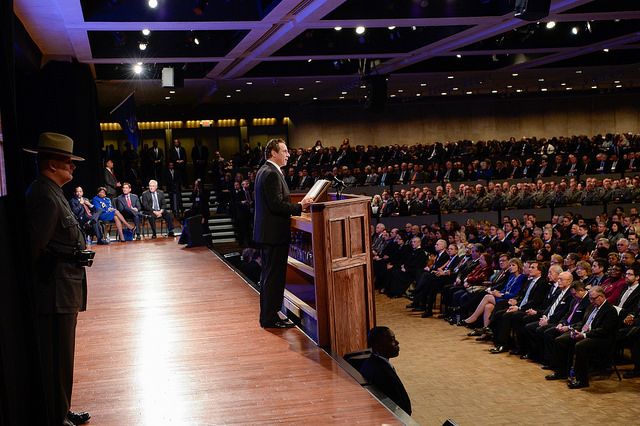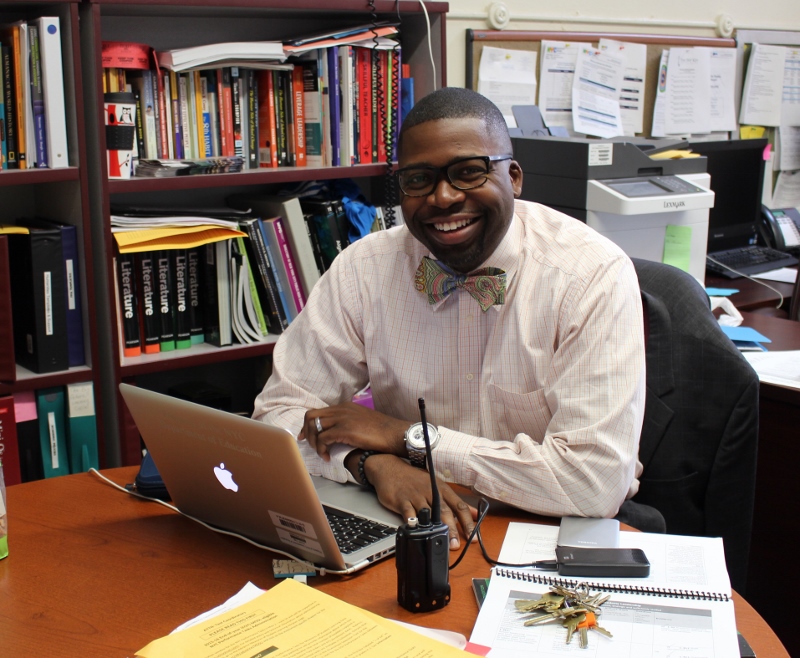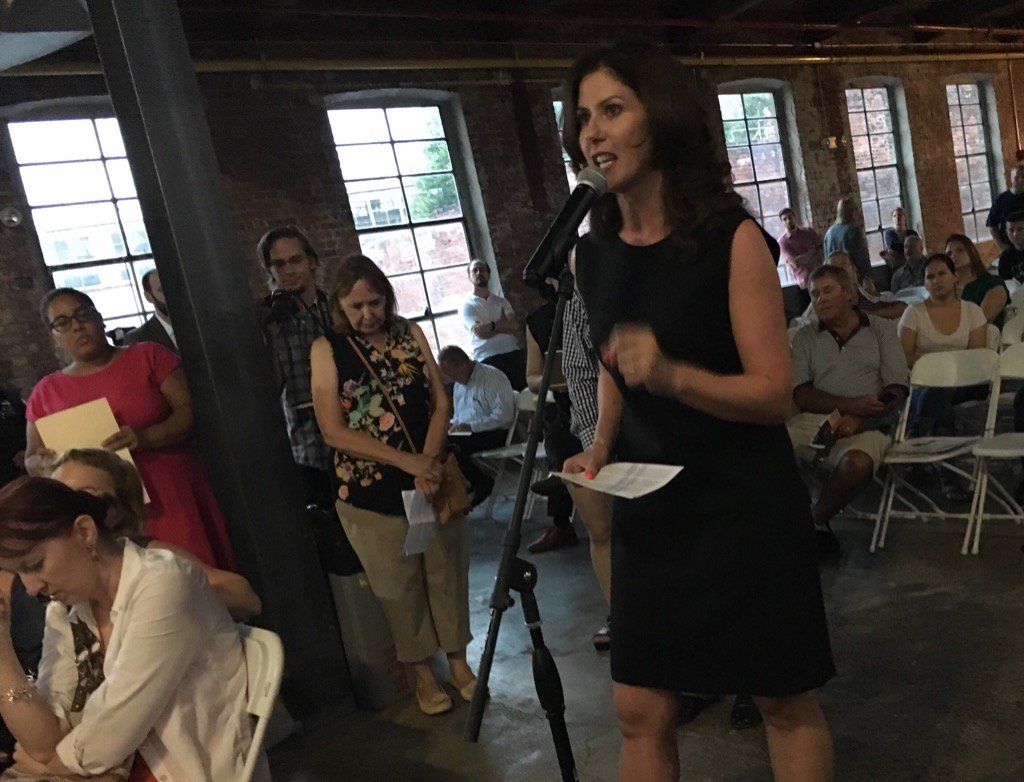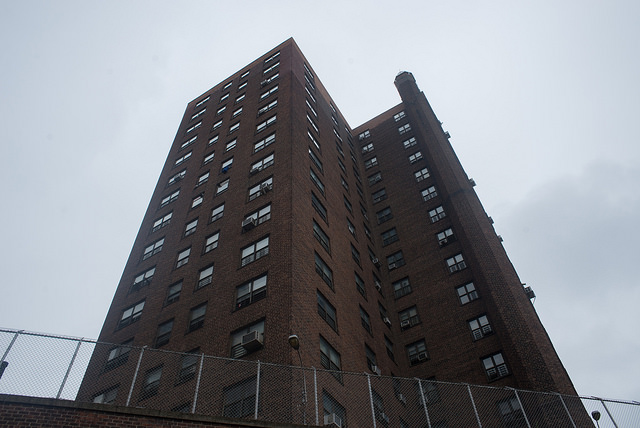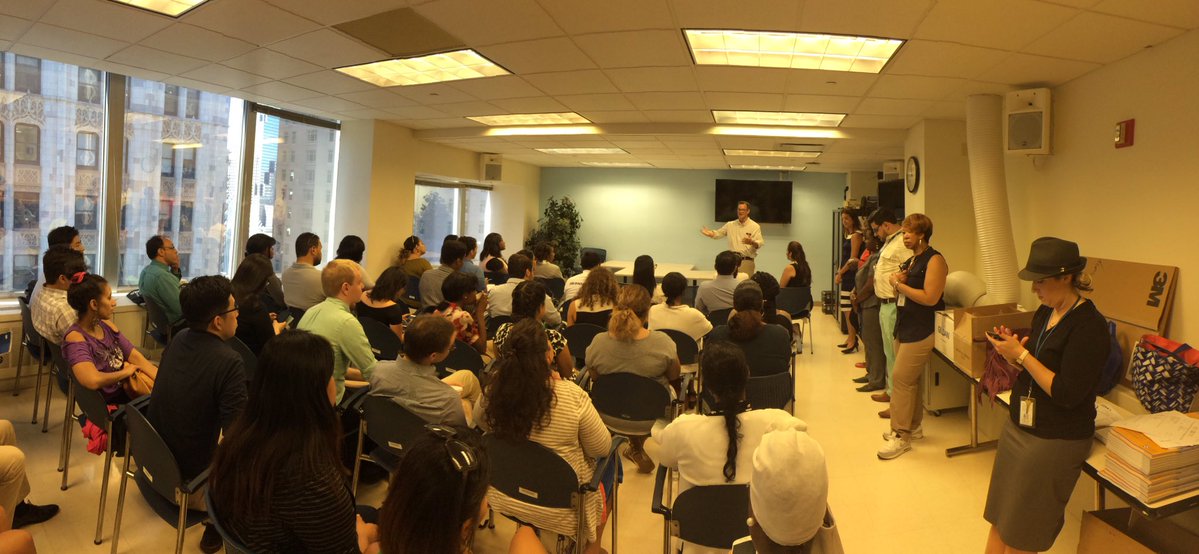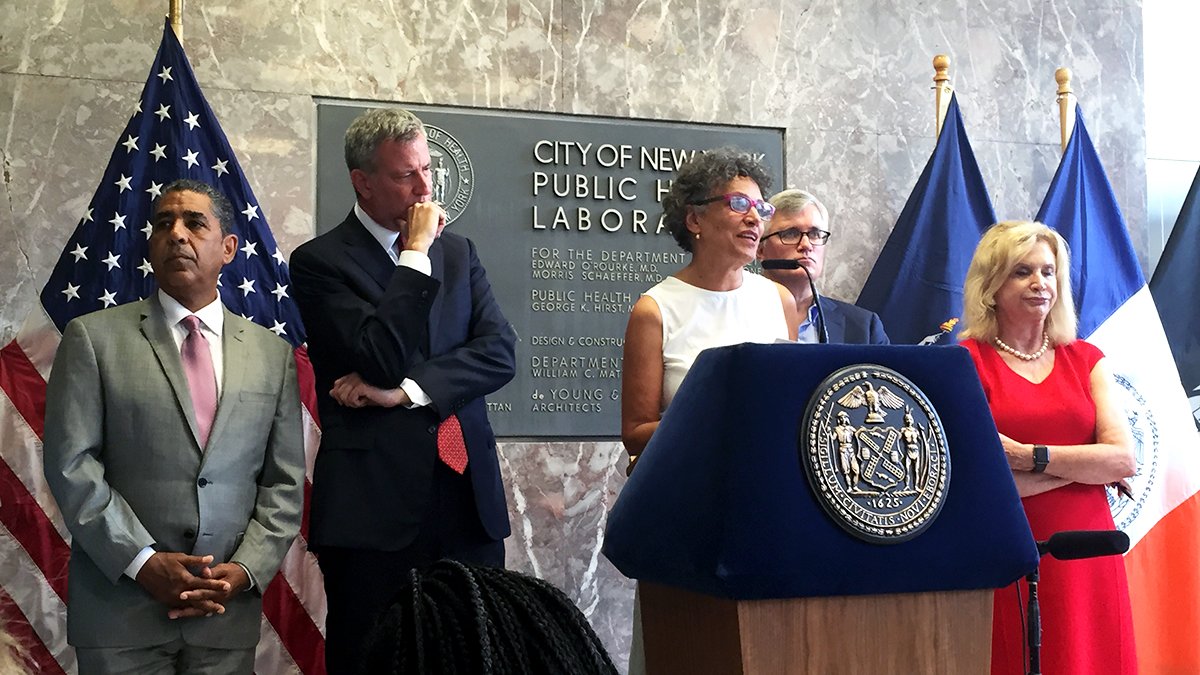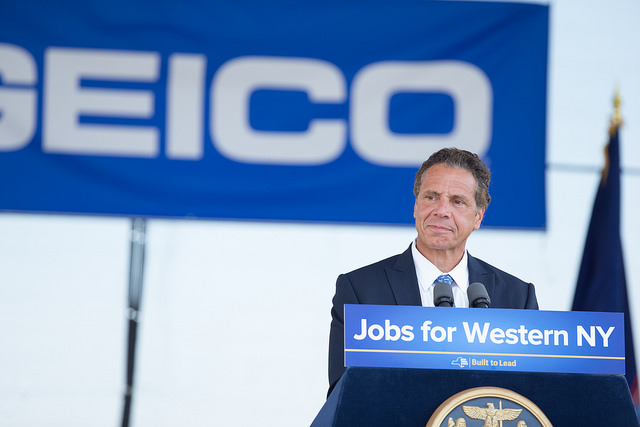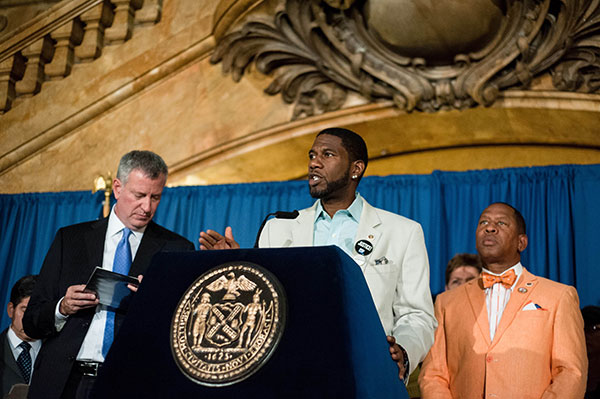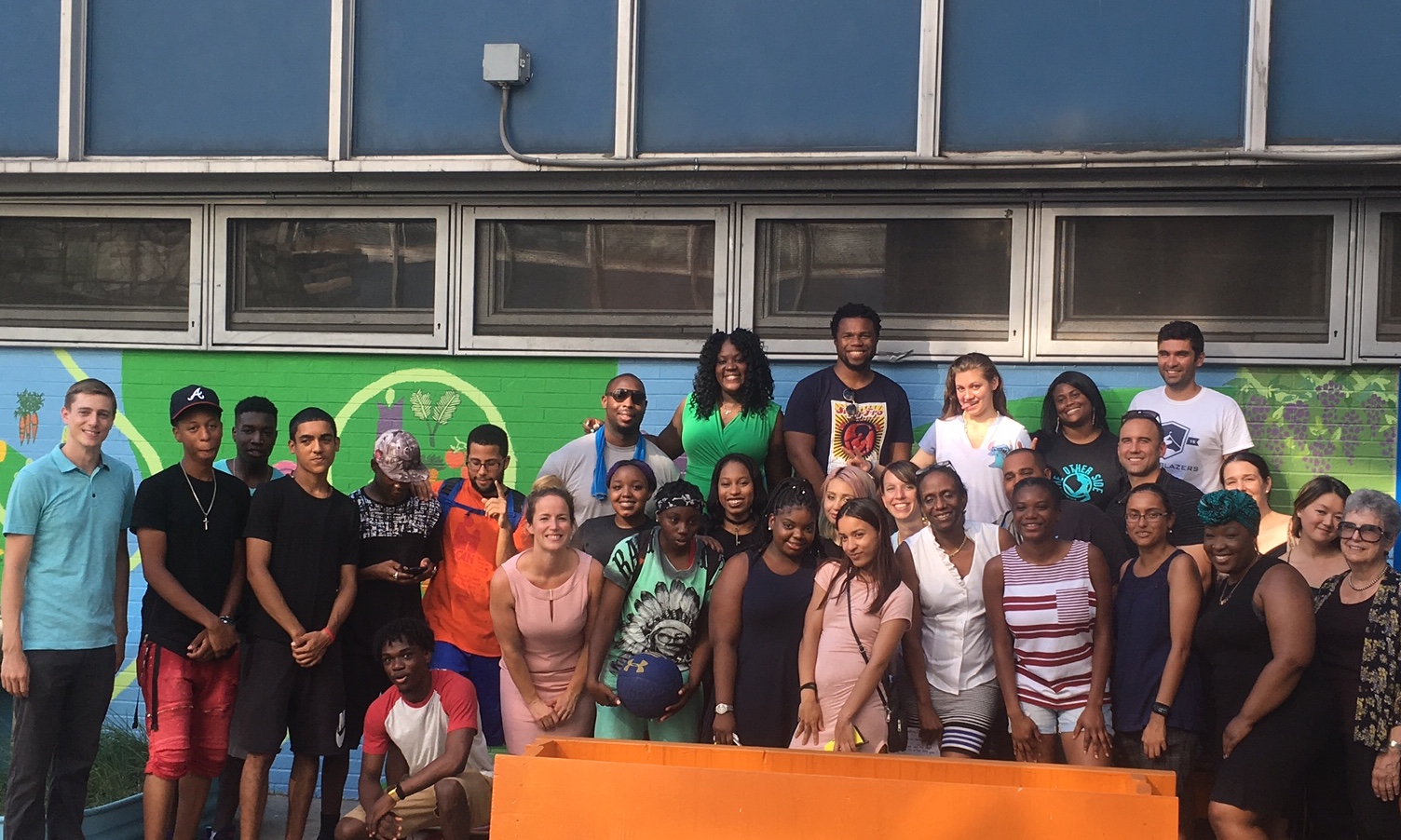
reunion photo by Chrystina Russell, former principal of Global Tech
In July, I found myself back in the East Harlem cafeteria shared by Global Technology Preparatory and P.S. 7. The occasion for my visit was a reunion of Global Tech’s first class of eighth-graders, who were now, four years after their middle-school commencement, graduating from high school.
I was eager to return and see how the students had fared. I knew from my ongoing contacts with the school and its students that several had endured more than their fair share of tragedy, including homelessness, violence and depression, and yet many were getting ready to go to college. There were, however, at least two boys who would not make it to graduation because they were at Rikers Island.
Global Tech, as the middle school became known, was one of the first public schools that I began to follow as part of my research on how business ideas, especially those of New York City Mayor Michael Bloomberg, would influence K-12 education. I was curious to see how a school that was seen, in many ways, as a Bloomberg-era success story was faring under the administration of Mayor Bill de Blasio, and his schools chancellor, Carmen Fariña. A number of changes, some driven by the new administration’s desire to merge small schools—a major departure from Bloomberg policy—foreshadowed significant shifts at the school.
I learned about Global Tech when I served on the New York State Regents’ Committee to redraft the ELA standards, and shared train rides back from Albany to the city with Jackie Pryce-Harvey, one of the few educators on the committee who was both African-American and who taught in the inner-city. (The committee’s proposal was jettisoned when New York adopted the Common Core.) At the time, Pryce-Harvey was getting ready to launch Global Tech with her friend Chrystina Russell.
Pryce-Harvey and Russell had met in the New York City Teaching Fellows program and hit it off immediately—though they were an unlikely team. Pryce-Harvey, an immigrant from Jamaica, was in her 50s when she and Russell launched the technology-focused middle school in East Harlem. Pryce-Harvey’s technological skills didn’t extend much beyond sending emails.
Russell, by contrast, was 28 at the time they opened their school, and came from Muskegon, MI, an affluent white town, and a family of staunch Republicans. When it came to education, there was little about traditional schooling that Russell wanted for her kids; poor, inner-city, children of color should have access to the best technology because once they learn how to use the web and become thoughtful consumers of online information, they don’t have to worry as much about not knowing the texts written by old white men, she was sure.
However, both women were part of a generation of educators who had developed their careers in the wake of New York City’s small-schools movement, which dates back at least to Tony Alvarado and Debbie Meier’s “Miracle in Harlem,” which began in District 4 in the 1970s, and was newly embraced by Bloomberg.
Global Tech joined the administration’s “Innovation Zone,” or iZone initiative, to use “new” approaches to education, including digital technology and more flexible class schedules, such as longer learning blocks and extended school days, to improve student engagement and performance. (Flexible class schedules had actually been pioneered in New York City years before the Bloomberg administration.)
Many early iZone schools dropped out of the program. But Global Tech thrived, and the school eagerly signed onto Chancellor Joel Klein’s grand bargain of increased autonomy in exchange for accountability. But, in the Alvarado-Meier tradition, Russell and Pryce-Harvey also saw their school as a collaborative venture in which they would work closely with both teachers and their community.
Both women were also trained as special education teachers and were committed to welcoming kids with special needs and mainstreaming them. Surrounded by charter schools, the special needs population at Global Tech - as at many neighboring Harlem schools - climbed sharply, from about 30 percent its first year to over 40 percent in recent years. Global Tech is a universal Title I school full of students from low-income households; almost all its students are black and Latino.
Pryce-Harvey was willing to help mid-wife the new school and to serve as the unofficial assistant principal—at least until she completed the administrator’s certification she would soon start working on. But, she was already planning her retirement and was sure she was not prepared to run the show. Instead, she encouraged Russell, who had graduated from the NYC Leadership Academy, a Bloomberg-era principal training program, to take the lead at their school, which featured a one-to-one student-to-laptop computer model.
And so it was that during the summer of 2009 the two women began hosting Sunday brunches in Pryce-Harvey’s Harlem brownstone for about half-a-dozen teachers who were hoping to teach at the school. None would be officially hired until the end of the summer. As Pryce-Harvey’s frequent travel companion to Albany, she invited me to attend the brunches and watch the school incubate.
The brunch participants included Jhonary Bridgemohan, who had once dreamed of becoming a mortician, but was now teaching English-Language Arts, as well as David Baiz, who had been rated “unsatisfactory” at the South Bronx school where he was then teaching, and feared he would be unfairly forced out.
Both Baiz and Bridgemohan had been mentored by Pryce-Harvey at PS/MS 4 in the South Bronx, which all three described as utterly dysfunctional and were eager to escape.
Now, seven years later, Russell has moved on to other educational ventures. (She first helped launch a hybrid university in Kigali, Rwanda, for Kepler, an educational nonprofit, and recently became a vice president at Southern New Hampshire University.)
Russell’s tenure at Global Tech serves, at least in part, as a commentary on the limits of the Bloomberg/Klein efforts to rein in the educational bureaucracy. Making the most of the autonomy-for-accountability bargain the administration promised, she raised hundreds of thousands of dollars in private funding for Global Tech from companies like GE and Cisco and invested in a slew of opportunities for her kids, including an extended day program via Citizens Schools and an arrangement with Computers for Youth, which, for a time, provided a home computer for every Global Tech child.
An inveterate rule breaker, Russell also would field 27 bureaucratic investigations during her three years as Global Tech principal, though all but one would eventually be dismissed. The lone remaining charge—that fearing the loss of a treasured school secretary, an education-department veteran with both strong people skills and deep knowledge of bureaucratic arcana, when her family moved to Connecticut, Russell used privately raised funds to subsidize the secretary’s train tickets to work.
When I asked Russell, recently, if she could ever see herself back in the public school system, she responded elliptically: “The Bloomberg-Klein years were the ones for me.”
Russell groomed David Baiz as her successor. She had once said of Baiz: “David is skilled; he’s always moving forward.” “[H]e gives 125 percent” virtually every day, she added.
Baiz’s accomplishments at Global Tech were considerable. He helped win the school thousands of dollars in grants and served as its de facto technology guru. A nationally recognized math teacher, he won a prestigious Math for America fellowship complete with a $15,000-per-year stipend. And he was selected as one of six New York City teachers to be part of the Digital Teacher Corps, a Ford Foundation-funded collaboration among educators, technologists, and designers to develop interactive digital learning tools. He was also beloved by students and respected by his colleagues.
Meanwhile, Pryce-Harvey has taken over as principal of P.S. 7, the K-to-8 school that shares a building with Global Tech.
The promotions of Baiz and Pryce-Harvey are a testament to Global Tech’s reputation. During 2012-2013, the school’s third year, and the last year for which such data is available—the de Blasio administration discontinued school grades as well as test-score comparisons among “peer” schools—Global Tech’s student growth scores were far above “peer schools” in both ELA and math. The scores were especially high for kids in the “bottom third” of their classes.
In math, the “growth scores” of the bottom-third of Global Tech students almost equaled the performance of a comparable cohort of students citywide—that is schools with both affluent and poor children. Global Tech also enjoyed a 94 percent attendance rate, far above “peer” schools. The school earned an “A” for the student progress portion of the report card, which measures how much individual students improved over the previous year, and a “highly developed” on the academic rigor portion of the evaluation.
Moreover, virtually everyone loved the school. On its Learning Environment Surveys, Global Tech scored well over 90 percent on almost every measure of parent, teacher, and student satisfaction.
But the future of Global Tech also could turn out to be a referendum on the leadership of Carmen Fariña, who is not particularly keen on small schools, and is reputed never to have met a Bloomberg-era innovation that she likes.
Even as Baiz and Russell, who had just returned from Rwanda, were hastily putting together the reunion, the future of the school is uncertain.
For the reunion, close to half of the 60-or-so students in Global Tech’s first cohort showed up in the school’s cafeteria, as well as most of the teachers who taught that first year, including a few who have moved on to other jobs. Many of Global Tech’s alums have been visiting the school throughout high school for help with homework, SAT prep, or just a chance to visit with teachers who have served as their mentors since middle school. During close to two dozen visits to the school during the past two years, Global Tech alums have been a clear, regular presence.
Almost every alum at the reunion said she or he was going on to college—in most cases community college. Pryce-Harvey explained that four-year college was out of reach for most Global Tech alums unless they received hefty scholarships.
Kaira was a stand-out in her Global Tech class, and served as valedictorian of her graduating class at the iSchool, another flagship Bloomberg venture. She had dreamed of attending Stanford University, but as an undocumented student who has spent much of her teen years without a fixed address—and sometimes homeless—she is instead going to John Jay College of Criminal Justice, part of the City University of New York.
To hear Kaira tell it, school, especially at Global Tech, has been a refuge and a beacon. “It may be that I’m struggling with a problem in English class or math, but it’s nothing like whatever struggle I deal with at home,” Kaira said. “It’s easier to find solutions” to those academic problems, than the ones she faces in her personal life.
“My education has always been a therapeutic experience,” she said. “That place where I can escape.”
Kaira sings the praises of her iSchool teachers who held regular after-school office hours. But in her sophomore year, when she needed help with her American history Regents exam, she turned to her old math teacher, Mr. Baiz. Later, he helped her with AP English, “which is bizarre,” says the 18-year-old with a big smile.
For Kaira, teachers like Baiz and Bridgemohan have been a much needed anchor. Global Tech is also the place where she learned to dream big and to believe that she might be able to go to college.
Tabitha, Kaira’s classmate both at the iSchool and at Global Tech, also leaned on her middle-school teachers when times got tough. When Tabitha landed in a homeless shelter in her junior year of high school and suffered from depression, she fell behind in her school work. But she kept showing up occasionally at Global Tech. Baiz worried that Tabitha might not finish high school and consulted with the iSchool’s administration. Tabitha, too, succeeded in graduating and is planning on attending community college.
Miguel said of himself, at the reunion, that he had been a “horrible student” at Global Tech, one who was “always suspended”—though the suspensions usually involved doing his school work in Russell’s office. He transferred in and out of high schools, but eventually got his GED. He’s now enrolling in CUNY’s BMCC and planning to major in business management.
Raimi was one of several Global Tech students who got into Manhattan Hunter Science High, which has an early college arrangement that allows seniors to take college courses at Hunter College during their senior year. Raimi now has a four-year scholarship to Hunter College.
Raven, another Global Tech student who got into Manhattan Hunter Science, regularly sought out Baiz both for help with her math homework and for much needed advice as, for example, when she decided to transfer to a less competitive high school. Raven is taking a gap year and thinking of joining the military.
Quentin went from Global Tech to Cardinal Hayes, which he described as a “really good” Catholic school; but when the tuition fees got too high for his mom, he transferred to Life Sciences Secondary School. He found the transition from private school back to public school “difficult,” he says. He “got too comfortable,” but snapped back at the “last second.” He says he’s going to Monroe College in New Rochelle. His goal, he says without prompting, is “to take my mom out of the ‘hood.”
Ismauri attended Manhattan Business Academy High and is going to the College of Staten Island. Travis is going to New York City Tech, a four-year CUNY college. Kamarthi got a basketball scholarship to attend SUNY Buffalo. Adonia is going to St. Francis in Brooklyn.
Dariya and Dariel, a sister-brother duo, are both going to Dutchess Community College. Dariya is planning to become a cosmetologist. Her brother, Dariel, has been completing a vocational program in auto mechanics and working in an auto shop through high school; he plans to become a mechanic.
Several students who didn’t get word of the reunion in time or couldn’t attend also are headed to college, among them David and Derek.
“Global Tech is a real family,” said Maria, one of the only parents who attended the reunion, there with her daughter, Amanda, who will be attending Guttman Community College in the Fall. “Of all the schools Amanda went to, this was the one with heart,” Maria said.
Yet, not all Global Tech graduates have overcome the considerable obstacles these kids face—including the gangs that rule the housing projects where many of them live. Two boys from the inaugural Global Tech class are in jail at Rikers Island awaiting sentencing. News of what had happened to a boy named Franklin hit Russell and Pryce-Harvey particularly hard. “I'm devastated,” emailed Russell when she first got the news this Spring. “Love that kid. And wow did Jackie and I ever spend a lot of time with him and his family.”
Russell and Pryce-Harvey both visited Franklin at Rikers and Russell showed up in court. Russell, who says she considers Franklin’s incarceration a “personal failure,” has petitioned the judge to allow her to take Franklin with her to Boston—and away from bad influences in his neighborhood; she wants to enroll him in a GED program and, eventually, at Southern New Hampshire University. She is awaiting the court’s decision. Russell says of Franklin: “He has no hate in his heart. And he is so smart.”
In a letter he wrote to the judge while he was incarcerated at Rikers, Franklin pleaded for the opportunity to finish his education.
The reunion in the Global Tech cafeteria had the air of celebration. Most of the students had kept up with at least one or two teachers from the school. Some had attended earlier pizza parties for alums. But there were hugs and high-fives as kids who hadn’t seen each other in four years reconnected.
Yet, unbeknownst to its alumni, Global Tech faces an uncertain future. In a reversal of Bloomberg’s small-schools policy, Farina plans to merge dozens of small schools, arguing that mergers will create economies of scale and allow schools to offer more programs.
Rumors that a new District 4 superintendent, Alexandra Estrella, was planning to merge Global Tech and P.S. 7 began swirling over a year ago. At the time, P.S. 7 was run by Sameer Talati, whose once cordial relationship with Global Tech had begun to deteriorate. According to several people close to Global Tech, Baiz suggested to Talati that they propose merging the two middle schools under Global Tech’s leadership and that Talati continue running the P.S. 7 elementary school. Talati, however, is said to have made a bid to run both schools.
Many educators familiar with Harlem schools consider Global Tech to be the stronger school, and urged Baiz to fight to lead any merger. Somewhat belatedly, Baiz, whose strengths as an educator do not include bureaucratic politics, was persuaded to make the case that Global Tech should be the lead school in a merger.
Talati eventually moved to DOE headquarters. Pryce-Harvey was appointed interim principal at P.S. 7. Baiz, for now, remains in charge of Global Tech.
But the ground under Global Tech continues to shift. The rumors of a merger still abound. Meanwhile, Baiz was turned down for tenure and the school’s most recent quality review, dated 2014-2015, was decidedly mediocre even though more than one experienced educator has referred to him as “one of the best principals in Harlem.”
On the only “quality review” posted by the DOE under Fariña, Global Tech earned a “developing”—the second lowest on a four-point scale—on two of five evaluation criteria, and a “proficient” on three criteria. The school did not earn a single “well developed”—the highest rating—not even for school culture, even though, since its inception, Global Tech has scored off-the-charts school-environment surveys.
By contrast, the administration gave P.S. 7, under Talati, six ‘proficients,’ four ‘well-developeds,’ and no ‘developings’ on his last quality review in 2013-2014, on a slightly more detailed rubric than the one used by the DOE the following year.
Similarly, on P.S. 7’s next quality review, which took place just two months after Pryce-Harvey took over, the school received four ‘proficients,’ one ‘well-developed,’ and no ‘developings.’
Baiz’s mistake, says one educator close to the school, was that he didn’t “play the game,” relying on the reviewer to look at the students “digital portfolios” where students keep copies of their work.
Russell also believes that Baiz’s reluctance to fight the planned takeover by P.S. 7 may have been “viewed as weakness” by the superintendent.
Whatever the case, Pryce-Harvey, at P.S. 7, had carefully prepared for her review, having her teachers refine lesson plans to show, among other things, how they reflected administrator observations and feedback and how that feedback had positively impacted student performance on, say, test scores. The revised lesson plans were then placed, along with other school data, in two binders, each three-to-four inches thick, neatly separated by tabs listing key elements of the quality-review rubric—including curriculum, parent engagement, and teacher evaluations.
New York City educators loved to hate the Bloomberg/Klein administration, with its penchant for serial reorganizations and its army of MBAs. At the same time, some of the city’s best principals conceded that the businessman-mayor’s school administration had made their lives easier. For principals who survived the New York City iZone’s many incarnations, or who had inherited the small-school mantel from Meier and Alvarado, the Bloomberg years were an opportunity to experiment with some relief from bureaucratic control.
However, the Bloomberg/Klein era was also one of creative destruction, which has been described by insiders as a deliberate Humpty Dumpty strategy—one designed to break the education bureaucracy such that it could never be put back together again. If so, the strategy has proved short-lived.
Under the de Blasio/Farina administration, according to many city educators, micromanagement is once again rampant. Even the most prized power conferred on principals by Klein—control over their budgets—has not proved sacrosanct. For example, when Baiz sought to promote Bridgemohan, his long-time colleague, to fill Pryce-Harvey’s shoes as assistant principal, Estrella is said to have nixed the plan. It was the sort of interference in principal decision making unprecedented in Global Tech’s seven year history.
Estrella did not return repeated requests for an interview.
Many seasoned educators have voted with their feet. Spurred by new testing and teacher-evaluation mandates, as well as dismay over meddling by a newly muscular central administration, several veteran principals retired or transferred to new jobs at the end of the Bloomberg administration and beginning of the de Blasio administration. Many of those who remain report feeling increasingly frustrated, especially by what they describe as the new administration’s micromanagement.
For Global Tech, one of the few certainties is that as long as Baiz and the school’s long-time teachers remain, they will continue to serve a much needed support for students and alums.
PRIOR COVERAGE OF GLOBAL TECH, THE IZONE, & MORE FROM ANDREA GABOR:
A Harlem Middle School Bets on Technology
City Schools Gamble on Going Digitial
In the Waning Months of Bloomberg's Tenure, A Signature Education Innovation is at a Crossroads
When Making a Great Teacher is a Team Effort
***
Andrea Gabor is the Bloomberg Professor of Business Journalism at Baruch College/CUNY and is working on a new book on education reform. On Twitter @aagabor.
***
Have an op-ed idea or submission for Gotham Gazette? Email This email address is being protected from spambots. You need JavaScript enabled to view it.
